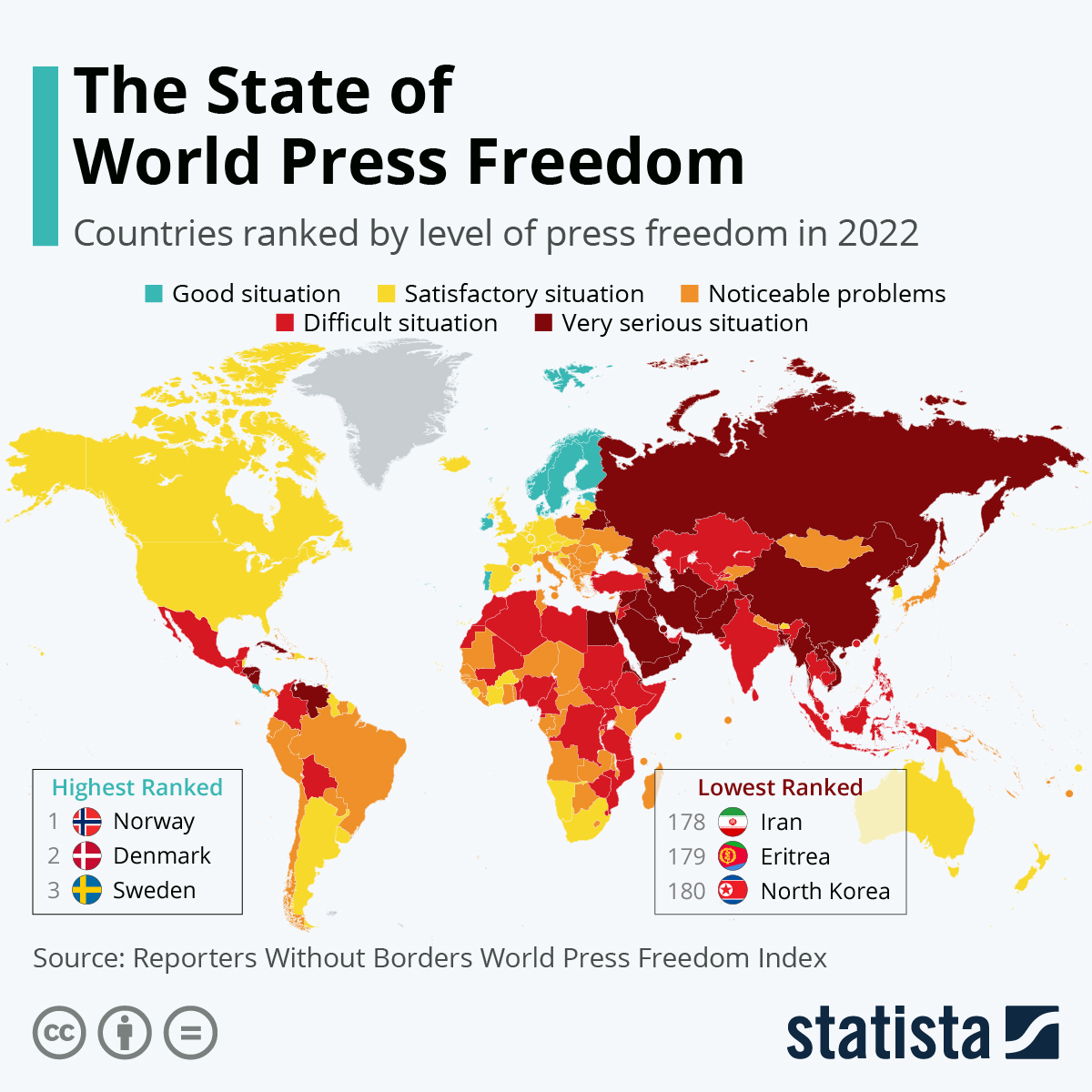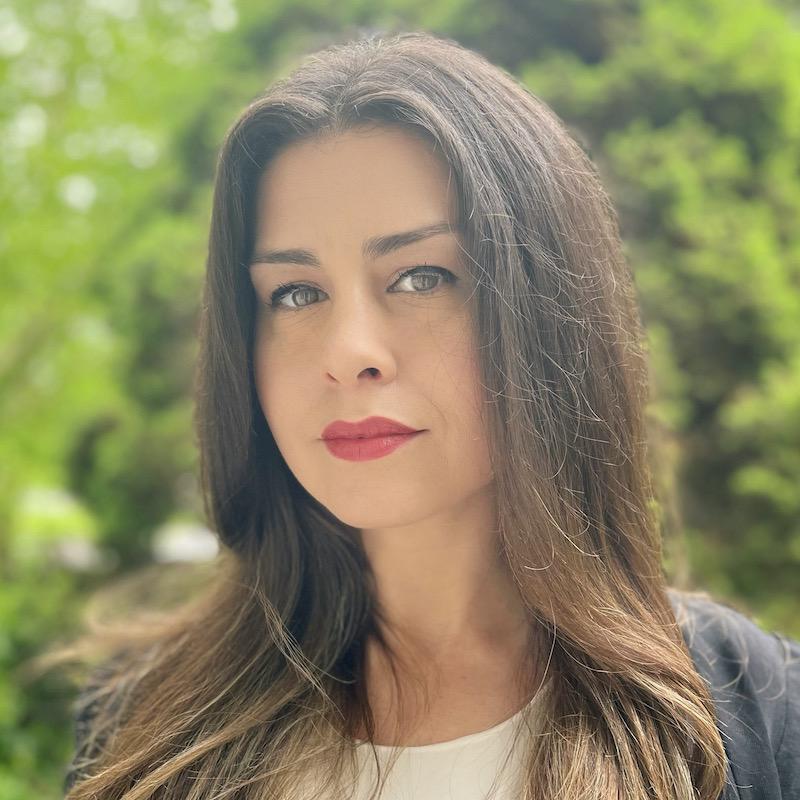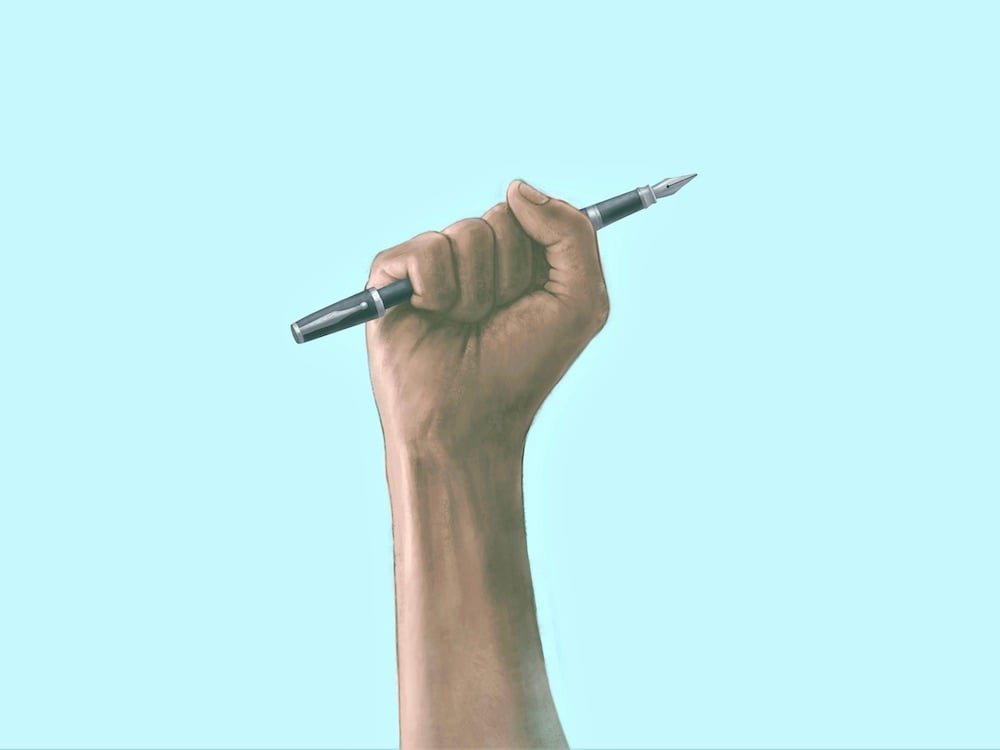[Editor’s note: The Tyee is proud to publish here the winner of the 2022 Dalton Camp Award, presented annually by FRIENDS (formerly FRIENDS of Canadian Broadcasting) for the best essay on the link between media and democracy. Read more about the prize in the sidebar to this story.]
“We were detained for days in cold cells. They took most of our clothes, denied us soap and toothbrushes, and only allowed us to speak to our lawyers.”
On its website, Reporters Without Borders has a brightly coloured interactive map of the world illustrating the results of its World Press Freedom Index, which identifies nations deemed to adequately uphold press freedoms within their borders. Green indicates countries with a “good situation,” yellow means “satisfactory,” light orange is “problematic,” dark orange is “difficult,” and red is “very serious.” The Arab region, including Egypt, where I have roots, is largely and unambiguously demarcated by red, while Canada is yellow.
And yet the opening quote was not uttered by a journalist from the red or orange nations. These are the words of photojournalist Amber Bracken, detailing her treatment at the hands of the RCMP in Canada last year. And they are hauntingly similar to words we have read and heard frequently from journalists working under seemingly impossible circumstances in countries relegated to the inglorious lower levels of the press freedom rankings.
If the red areas on the world map represent an information gap, dark red cracks have gradually been tarnishing Canada’s bright yellow reputation. On Nov. 19, 2021, two journalists, including Bracken, and several protesters, including Sleydo’ Molly Wickham, a wing Chief of the Gidimt’en clan, and Jocey Alec, daughter of Hereditary Chief Woos, were arrested on the Coastal GasLink drill site near the Wedzin Kwa (Morice) River in British Columbia.
As well, since a May 2021 injunction against the Fairy Creek blockade, more than 1,100 protesters have been arrested on southern Vancouver Island as they fought to protect what remains of our old-growth forests and First Nations territories. During the blockade, the largest act of civil disobedience in Canadian history, the media was shackled behind a vast exclusion zone, with the RCMP initially prohibiting all journalists from entering the area.
On the day of the Coastal GasLink arrests, I felt the need to rub my eyes when I read a headline calling into question Canada’s press freedom. Was I reading this right? Surely there must be a mix-up. And when I read of the attempt to block the collection and dissemination of information on the Fairy Creek protest, I thought of the media blackout in Egypt during the early days of the 2011 Revolution. With tens of thousands of people on the street demanding their basic rights, the state-controlled broadcaster continued to present its regular programming, completely denying the reality unfolding on its streets. What was that if not a clear example of democratic failure?
For more than a decade, I have studied and worked on media in areas that include some of the most commonly cited violators of press freedom in the world, researching and writing on the Arab region and its media landscape for international media outlets, commentary websites and academic journals. I began my career hungry to change stereotypical representations of Arabs in the West, and became engrossed in the intricate and at times dangerous web of the region’s diverse and complex media systems. Implanting myself in them seemed like the only fair way to make my own determinations on the narratives of oppression and censorship.
By virtue of genetics and close family ties, I have always felt a deep connection to the Arab region, and to Egypt specifically. My father moved from there to Canada in 1969 to complete his PhD at the University of Waterloo, where he met my Saskatchewan-born mother, who was also pursuing her PhD. I have existed in an odd balance, firmly Canadian but abundantly aware of my roots and the responsibilities that I internalized as a result of those roots. But if I were to be truly, uncomfortably honest, my relationship to the Arab region within the context of my work has always been from the vantage point of looking in from outside — even, dare I say, from above — holding pride and confidence in the freedoms afforded to us as Canadians, and as Canadians working on or in the media.
I feel certain I am not alone in these sentiments. As Canadians born here, as well as new immigrants and aspiring ones, we all believe ourselves to belong in the yellow. And we are perceived as such.
We are a refuge. We are a representation of safety, of inclusion, of freedom. We, as a nation, are aspirational to so many. And yet for many of our own, we continue to fail.
This should not be a heavy burden to bear, but rather an incentive to strengthen and reinforce the values that have afforded Canada this reputation. It should be an incentive to fully embody these ideals by, for example, breaking the pattern of misrepresentation and underrepresentation of Indigenous and First Nations communities, while standing against violators of human rights and press freedoms elsewhere.
Unfortunately, for individuals immersed in this subject a fatigue can begin to emerge, and often with it a regrettable complacency. It took a murder as ghastly and shocking as Jamal Khashoggi’s for me, and much of the world, to re-examine the degree of danger faced by journalists in the regions I study and beyond. Reports of journalists being arrested, detained, gagged, harassed or worse are so common that one barely feels compelled to read the headline in its entirety — exhausted by the frequency of such reports, and unwilling to fully face the feeling of helplessness that comes with it.

When one digs a little deeper into our own Canadian failures when it comes to democracy, representation and press freedom, a complicated picture emerges, one that echoes the fatigue and helplessness I have felt so frequently working on media in the Arab region.
In 2018, while exploring media coverage of Indigenous issues in Canada, veteran Mohawk journalist Dan David reflected on the explanations he had received as a young local news reporter in the Prairies for why Indigenous issues were covered so poorly. David wrote that he was given the usual excuses: Time. Tight schedules. Inadequate resources. Dependence on advertisements for goods and services that would not be purchased by poor people.
But David was also given another explanation for the lack of coverage: No journalistic payoff. While journalists thrive on exposing corruption and injustice, the non-financial remuneration for that work is the knowledge that it has had a positive impact — and most of the time, that is not the case. “Stories about Indigenous communities never went anywhere. Things never changed,” he wrote.
While David admits that there has been progress since the informal survey he conducted as a young man nearly 30 years ago, other journalists have identified a pattern of something even more disturbing than the systemic negligence toward Canada’s Indigenous communities: a planned and aggressively enforced prohibition of coverage. So what happens when something that has long been ignored ceases to be ignored? For our purposes, we must also interrogate what happens to the journalists who dare to cover it.
In any context where financial, political or religious interests are at play, there exists a tension between journalists’ incentives for coverage and the incentives of those in positions of power to limit or control the coverage of certain issues. Unfortunately, it is almost always the journalists who are at a disadvantage, with more to lose. While the degree of risk varies by issue and region, that tension exists from Riyadh to Regina. In the arrests of Bracken, her colleague Michael Toledano and so many others, we see the price of fighting to hold power to account.
I am not the first to draw comparisons between the failures of Canadian democracy and those of our authoritarian counterparts. Global News reporter Paul Johnson likened the restrictions imposed on reporters covering Fairy Creek to those he had faced while reporting in places such as China. And in response to the same events, the president of the Canadian Association of Journalists, Brent Jolly, decried the attempts by the RCMP to “hide behind a curtain and execute their orders in complete darkness.”
“Maybe that’s OK in a dictatorship,” said Jolly, “but it’s not acceptable here in Canada.”
Dark red cracks.
I, like so many other journalists, media researchers and communicators, entered this field — forgive the colloquialism — bright-eyed and bushy-tailed. My optimism in the power of the word, and its ability to change narratives and consequently the lives of underrepresented or inaccurately represented populations, is squarely rooted in my Canadian-ness.
It is for this reason that the arrests of Bracken and Toledano — and other similar events, particularly those relating to the coverage of Indigenous land defenders — are so jarring, and such a big deal. The point is not to compare the press freedom violations that occur in Canada with those that take place in more oppressive or authoritarian countries or contexts. The point is to hold up a mirror to the actual exercise — successful or not — of our ideals. The point is to examine the dark red cracks in the yellow concrete of our democracy and mend them with care and accountability. And those cracks are growing deeper. When I originally wrote this piece in 2021, Canada was ranked 14th on the World Press Freedom Index. Since then, it has fallen five spots, to 19th.
It is the similarities between the red and the yellow that we should all be concerned about — similarities that call into question our democracy, and the very fabric of our society. ![]()
Read more: Rights + Justice, Media
















Tyee Commenting Guidelines
Comments that violate guidelines risk being deleted, and violations may result in a temporary or permanent user ban. Maintain the spirit of good conversation to stay in the discussion.
*Please note The Tyee is not a forum for spreading misinformation about COVID-19, denying its existence or minimizing its risk to public health.
Do:
Do not: